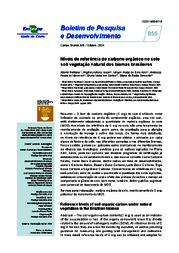Níveis de referência do carbono orgânico no solo sob vegetação natural dos biomas brasileiros.
Níveis de referência do carbono orgânico no solo sob vegetação natural dos biomas brasileiros.
Author(s): FONTANA, A.; VIVIAN, A. M.; ARCO, M. A. de L.; MENEZES, A. R. de; SANTOS, B. V.; CLEMENTE, E. de P.
Summary: RESUMO – O teor de carbono orgânico (C org) no solo é utilizado como indicador do acúmulo ou perda do componente orgânico, uma vez que, está diretamente relacionado a quantidade de matéria orgânica do solo (MOS). Aos níveis de referência de C org no solo, são uma ferramenta de monitoramento da evolução, assim como, de orientação para a aferição e orientação do manejo e cultivo das terras. De forma mais detalhada, os níveis de referência de C org podem ser obtidos e adotados por cada classe de textura do solo, nas diferentes camadas e nos diferentes biomas. Nesse sentido, podem ser aplicados como orientadores no monitoramento da efi cácia das tecnologias previstas para os cultivos agrícolas no Plano ABC. Ainda, pode ser aplicado aos diversos programas de certifi cação já estabelecidos ou em estabelecimento e, das marcas conceito Carne Carbono Neutro, Carne Baixo Carbono, dentre outras em fase de desenvolvimento, como o Carbono Nativo, Bezerro Baixo Carbono, Leite Baixo Carbono, Trigo Baixo Carbono e Soja Baixo Carbono. Com os teores de referência de C org, será possível, além de avaliar a quantidade e qualidade dos solos agrícolas, estabelecer uma relação de causa-efeito das práticas de cultivo e manejo ao componente orgânico do solo, bem como, também, defi nir padrões regionais com potencial de incremento de MOS. Abstract – The soil organic carbon content (C org) is used as an indicator of the accumulation or loss of the organic component, since it is directly related to the amount of soil organic matter (SOM). At reference levels of C org in the soil, they are a tool for monitoring evolution, as well as providing guidance for measuring and guiding land management and cultivation. In more detail, reference levels of C org can be obtained and adopted for each soil texture class, in the different layers and in the different biomes. In this sense, they can be applied as guidance in monitoring the effectiveness of technologies predicted for agricultural crops in the ABC Plan. Furthermore, it can be applied to the various certification programs already established or being established, and to the concept brands Neutral Carbon Meat, Low Carbon Meat, among others in the development phase, such as Native Carbon, Low Carbon Calf, Low Carbon Milk, Low Carbon Wheat and Low Carbon Soy. With the reference levels of C org, it will be possible, in addition to evaluating the quantity and quality of agricultural soils, to establish a cause-effect relationship between cultivation and management practices to the organic component of the soil, as well as defining regional standards with potential for increasing MOS.
Publication year: 2024
Types of publication: Booklets
Unit: Embrapa Beef Cattle
Keywords: Carbono, Matéria Orgânica, Monitoring, Soil organic matter, Solo, Vegetação
Observation
Some of Embrapa's publications are published as ePub files. To read them, use or download one of the following free software options to your computer or mobile device. Android: Google Play Books; IOS: iBooks; Windows and Linux: Calibre.
Access other publications
Access the Agricultural Research Database (BDPA) to consult Embrapa's full library collection and records.
Visit Embrapa Bookstore to purchase books and other publications sold by Embrapa.

